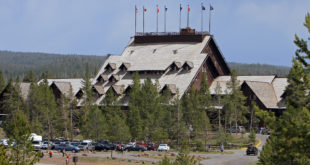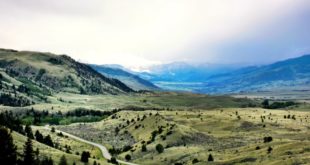That a distinct mountain bison once existed is not in much dispute. In fact, in the roughly ten thousand years since the last ice age, many different species of shaggy herbivore have lived in this area, including a version or two of the wooly mammoth. At the time of white man’s coming about 1800, mountain bison were the main species in the woods and meadows of Yellowstone. Early white explorers remarked about the differences between the mountain bison and the more familiar bison of the plains. According to National Park Service Scientific Monograph Number 1 by service biologist Margaret Meagher, “Historical accounts generally agree that, compared with the plains bison, these mountain animals were more hardy, fleet, and wary, and had darker, finer, curlier hair.” The two sub-species (in scientific nomenclature: plains bison – bison bison bison and mountain (or woods) bison – bison bison athabascae) have distinguishing skeletal forms and presumably distinct DNA.
This is where the controversy begins: The park service has maintained for some time that over a century the tiny population of mountain bison (in 1902 only 23 animals were known to have survived poaching and winter weather) has interbred with the plains bison that were introduced into Yellowstone. Over that time significant markable genetic differences between the sub-species has been erased. DNA studies have tended to confirm this point of view, although the park service says that studies continue.
 |
 |
The contrary opinion held by Mr. Jackson and others is that genetic differences or not, the Mirror Plateau bison exhibit behavior consistent with the historical accounts of mountain bison. The animals are extremely wary of humans, spend most of their time in the forests, travel in small herds (5-30 individuals), and do not migrate out of the park. The herd does migrate to lower elevation and winters in the Pelican Creek valley near Yellowstone Lake. Their point is that even with DNA testing showing conclusively that the Mirror Plateau herd has no significant genetic differences from the other Yellowstone herds (testing which has not yet been completed); the behavior of the Mirror Plateau herd should earn them special study and protection.
This shapes up like a classic hard science (DNA testing) and soft science (animal behavior) issue, which is a rather vast gray area, a battle zone really, between the genetic and behavioral sciences. Both sides are inclined to say the other over-emphasizes their importance. Proof in one camp is not seen as proof by the other camp…and so forth. From one angle at least, what’s interesting is that just like the larger issue involving the slaughter of bison, Yellowstone is a focal point of science, environmentalism, commerce, tourism, and national values. Even this seemingly esoteric argument over a remote herd of maybe 300 bison, is potentially explosive. It’s not hard to imagine that if this herd was proven to be, in fact, native bison, then a hue and cry would ensue to restore these indigenous animals and remove the plains bison not only from the park, but from the entire Greater Yellowstone Region. This would, of course, cause massive upheaval in (among other things) the regional bison management plan, the brucellosis campaign, and probably the park budget.
Budget is a key word here, as most modern science costs a lot of money. The tendency is to outline a problem – like this one — that cries out for systematic study, and find the money to do maybe one-tenth of it. In this case, because competing views of science are involved, the task of doing “appropriate” studies is itself difficult and controversial. It’s no wonder that the park service is not eager to embrace the issue, and no surprise that the people at PEER are so frustrated by the attitude of the park service.
 Yellowstone Insider Your Complete Guide to America's First National Park
Yellowstone Insider Your Complete Guide to America's First National Park





